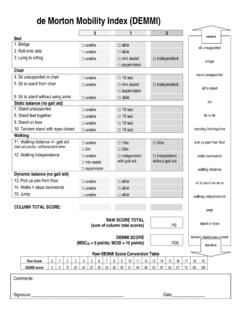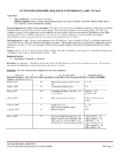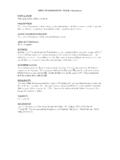Transcription of The Modified Falls Efficacy Scale (MFES) - Yola
1 Department of Human Services Working together to prevent Falls Form developed by: National Ageing Research Institute and North West Hospital Falls Clinic (adpated from Tinetti et al., 1990) A one-page form, consisting of 14 questions each related to a particular activity (eg getting dressed, taking a bath, crossing roads etc). Unlike the original Falls Efficacy Scale (developed by Tinetti et al, 1990), this Scale includes a greater range of outdoor activities. The questions aim to determine how confidently seniors feel they are able to undertake each activity on a Scale of 0 (not confident at all) to 10 (completely confident).
2 An evaluation of the MFES was reported in: Hill, K., J. Schwarz, et al (1996). Fear of falling revisited. Archives of Physical Medicine and Rehabilitation 77: 1025-1029. These preliminary findings indicated that the MFES was both a reliable and valid measure of Falls self- Efficacy . (Downloadable) --- --- In 2005 the Department of Human Services funded the National Ageing Research Institute to review and recommend a set of Falls prevention resources for general use. The materials used as the basis for this generic resource were developed by the National Ageing Research Institute and the North West Hospital Falls Clinic, Parkville (adapted from Tinetti et al.)
3 , 1990). This and other Falls prevention resources are available from the department s Aged Care website at: The Modified Falls Efficacy Scale (MFES) In 2005 the Department of Human Services funded the National Ageing Research Institute to review and recommend a set of Falls prevention resources for general use. The materials used as the basis for this generic resource were developed by the National Ageing Research Institute and the North West Hospital Falls Clinic, Parkville (adapted from Tinetti et al., 1990). This and other Falls prevention resources are available from the department s Aged Care website at: Working together to prevent Falls On a Scale of 0 to 10, how confident are you that you can do each of these activities without falling, with 0 meaning not confident/not sure at all , 5 being fairly confident/fairly sure , and 10 being completely confident/completely sure ?
4 NOTE: If you have stopped doing the activity at least partly because of being afraid of falling, score a 0; If you have stopped an activity purely because of a physical problem, leave that item blank (these items are not included in the calculation of the average MFES score). If you do not currently do the activity for other reasons, please rate that item based on how you perceive you would rate if you had to do the activity today. Not confident Fairly Completely at all confident confident 0 1 2 3 4 5 6 7 8 9 10 1.
5 Get dressed and undressed 0 5 10 2. Prepare a simple meal 0 5 10 3. Take a bath or a shower 0 5 10 4. Get in/out of a chair 0 5 10 5.
6 Get in/out of bed 0 5 10 6. Answer the door or telephone 0 5 10 7. Walk around the inside of your house 0 5 10 8. Reach into cabinets or closet 0 5 10 9.
7 Light housekeeping 0 5 10 10. Simple shopping 0 5 10 11. Using public transport 0 5 10 12. Crossing roads 13. Light gardening or hanging out 0 5 10 the washing* 0 5 10 14.
8 Using front or rear steps at home * rate most commonly performed of these activities Average score/item rated = ../.. = .. 1. Hill K, Schwarz J, et al. Fear of falling revisited. Archives Phys Med Rehabil 1996; 77:1025-1029. 2. Tinetti M, Richman D, Powell L. Falls Efficacy as a measure of fear of falling. J Gerontology 1990; 45:P239-43. The Modified Falls Efficacy ScaleAdapted from Tinetti et al, 1990; Hill et al, 1996




